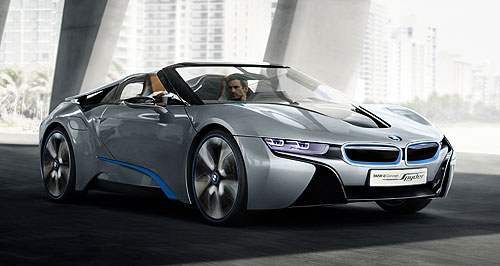Make / Model Search
Future models - BMW - i8Beijing show: BMW’s electrifying SpyderLid's off: A topless version of the BMW i8 plug-in hybrid supercar will make its public debut in Beijing later this month. Plug-in hybrid sports convertible to join 2+2 coupe in BMW i8 range2 Apr 2012 BMW will use this month’s Beijing motor show to pull the wraps from a topless version of its plug-in hybrid sports car, the i8. To be called i8 Spyder, the two-seat convertible concept is shorter in both wheelbase and overall length than the 2+2 coupe that was revealed in concept form at last year’s Frankfurt motor show, but adopts the same lightweight construction techniques and petrol-electric powertrain as the four-seater. European reports suggest the Spyder will make it into production in 2015, about two years after the i8 coupe that is slated for production next year alongside the smaller all-electric i3 city car in BMW’s environmentally friendly ‘I’ sub-brand. Despite all the weight-saving techniques such as aluminium underpinnings and carbon-reinforced plastic body, the Spyder weighs in at a hefty 1630kg but can accelerate from zero to 100km/h in five seconds and sip just three litres of petrol in 100km on the combined fuel test. Both i8 variants employ a 96kW electric motor driving the front wheels, with a 164kW ‘Twin Power’ turbocharged 1.5-litre three-cylinder engine driving the rear wheels for a total 260kW of power and 550Nm of torque.  The electric motor and petrol engine can run independently of each other or in tandem, propelling the Spyder to a top speed of 250km/h – or maybe more without the German electronic cutout. The electric motor and petrol engine can run independently of each other or in tandem, propelling the Spyder to a top speed of 250km/h – or maybe more without the German electronic cutout.BMW says sophisticated electronics control the split of power from the electric and petrol motors according to driving need, delivering front, rear or four-wheel drive. The Spyder can travel up to 30km on electric power alone from its lithium-ion battery pack, located in a tunnel running the length of the car, helping to give the vehicle a 50:50 front-rear weight split. The batteries can be recharged from a power point in two hours. The rear bulkhead reportedly has been moved forward compared with the coupe, helping to provide more room for the petrol engine. Luggage space is said to be only 100 litres – tight even for a sportscar, but naturally restricted due to the dual powertrain requirements under the bonnet and boot. It remains to be seen if the front-hinged, up-swinging doors make it into production, and how BMW will raise the roof. The company says a two-piece folding roof is planned, although none is shown in the images. Behind the driver, a transparent panel helps to provide some rear visibility under what appears to be roll-over protection hoops, probably made of carbon-fibre. A fastback profile is provided by what appear to be wing-like panels behind the doors, while the kidney grille has been blocked out for superior aerodynamic airflow around the front. The headlights are said to use pioneering laser light technology, in a u-shape design that is the hallmark of BMW’s i-design template. The bonnet has a distinctive V shape cut into it, revealing a semi-transparent cover over the front-mounted electric motor so passers-by can admire it. The BMW i8 Spyder is expected to be unveiled at the Beijing motor show on the press days, April 23 and 24. Meanwhile, BMW and Toyota have announced collaborative research on next-generation lithium-ion batteries. The research, which has already started, will focus on increasing the performance and capacity of lithium-ion battery cells through the use of new combinations of materials for cathodes, anodes and electrolytes. The agreement follows the memorandum of understanding collaboration on next-generation environment-friendly vehicles and technologies announced by the two companies in December.  Read moreAll motor show Alfa Romeo Alfa Romeo Abarth Abarth Alpine Alpine Alpina Alpina Audi Audi Aston Martin Aston Martin BMW BMW Bentley Bentley Chery Chery Brabham Brabham Chrysler Chrysler Chevrolet Chevrolet Cupra Cupra Citroen Citroen DS DS Dodge Dodge Fiat Fiat Ferrari Ferrari Foton Foton Ford Ford Great Wall Great Wall FPV FPV Haval Haval GWM GWM Honda Honda Holden Holden Hummer Hummer HSV HSV Infiniti Infiniti Hyundai Hyundai Jaguar Jaguar Isuzu Isuzu Kia Kia Jeep Jeep Land Rover Land Rover Lamborghini Lamborghini Lexus Lexus LDV LDV Mahindra Mahindra Lotus Lotus Mazda Mazda Maserati Maserati Mercedes-AMG Mercedes-AMG McLaren McLaren MG MG Mercedes-Benz Mercedes-Benz Mitsubishi Mitsubishi Mini Mini Opel Opel Nissan Nissan Peugeot Peugeot Pagani Pagani Proton Proton Porsche Porsche Renault Renault Ram Ram Rover Rover Rolls-Royce Rolls-Royce Skoda Skoda Saab Saab SsangYong SsangYong Smart Smart Suzuki Suzuki Subaru Subaru Toyota Toyota Tesla Tesla Volvo VolvoMotor industry news |
Click to shareAll motor show Alfa Romeo Alfa Romeo Abarth Abarth Alpine Alpine Alpina Alpina Audi Audi Aston Martin Aston Martin BMW BMW Bentley Bentley Chery Chery Brabham Brabham Chrysler Chrysler Chevrolet Chevrolet Cupra Cupra Citroen Citroen DS DS Dodge Dodge Fiat Fiat Ferrari Ferrari Foton Foton Ford Ford Great Wall Great Wall FPV FPV Haval Haval GWM GWM Honda Honda Holden Holden Hummer Hummer HSV HSV Infiniti Infiniti Hyundai Hyundai Jaguar Jaguar Isuzu Isuzu Kia Kia Jeep Jeep Land Rover Land Rover Lamborghini Lamborghini Lexus Lexus LDV LDV Mahindra Mahindra Lotus Lotus Mazda Mazda Maserati Maserati Mercedes-AMG Mercedes-AMG McLaren McLaren MG MG Mercedes-Benz Mercedes-Benz Mitsubishi Mitsubishi Mini Mini Opel Opel Nissan Nissan Peugeot Peugeot Pagani Pagani Proton Proton Porsche Porsche Renault Renault Ram Ram Rover Rover Rolls-Royce Rolls-Royce Skoda Skoda Saab Saab SsangYong SsangYong Smart Smart Suzuki Suzuki Subaru Subaru Toyota Toyota Tesla Tesla Volvo VolvoMotor industry news |











Facebook Twitter Instagram